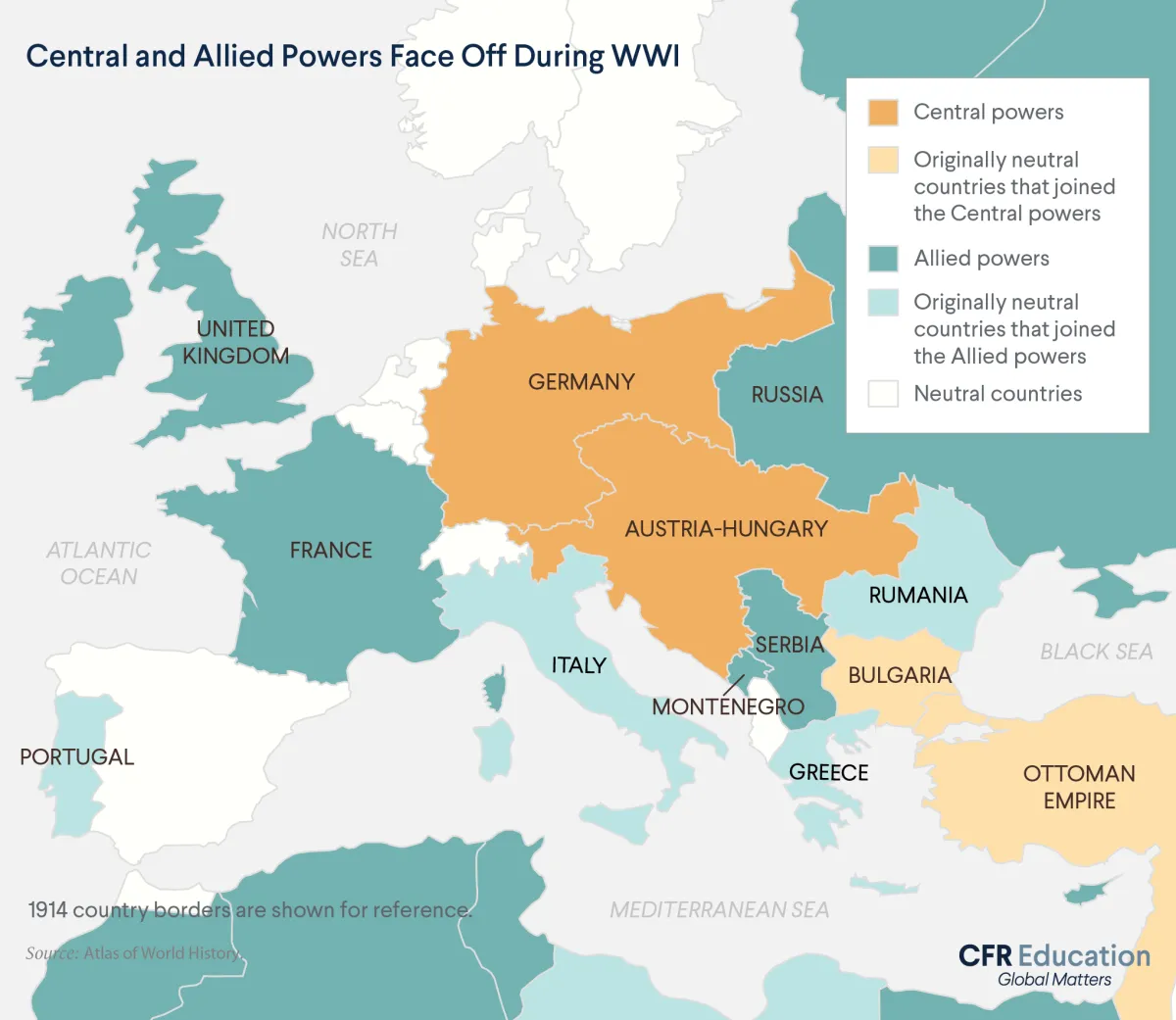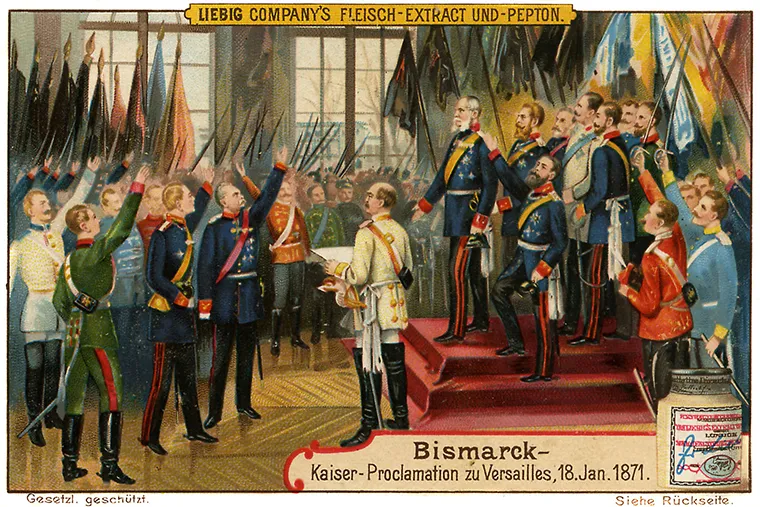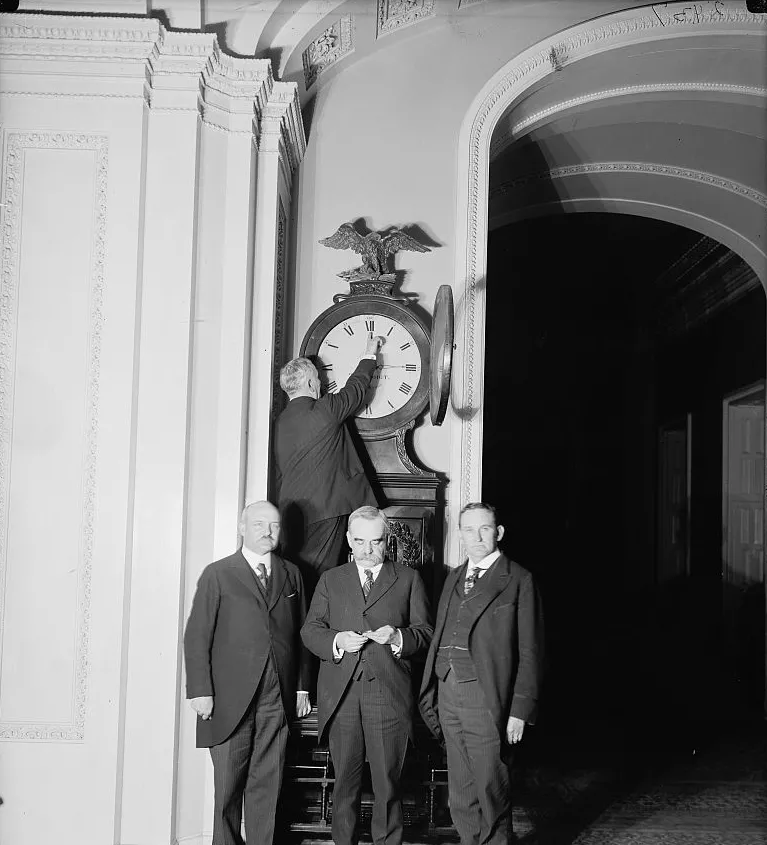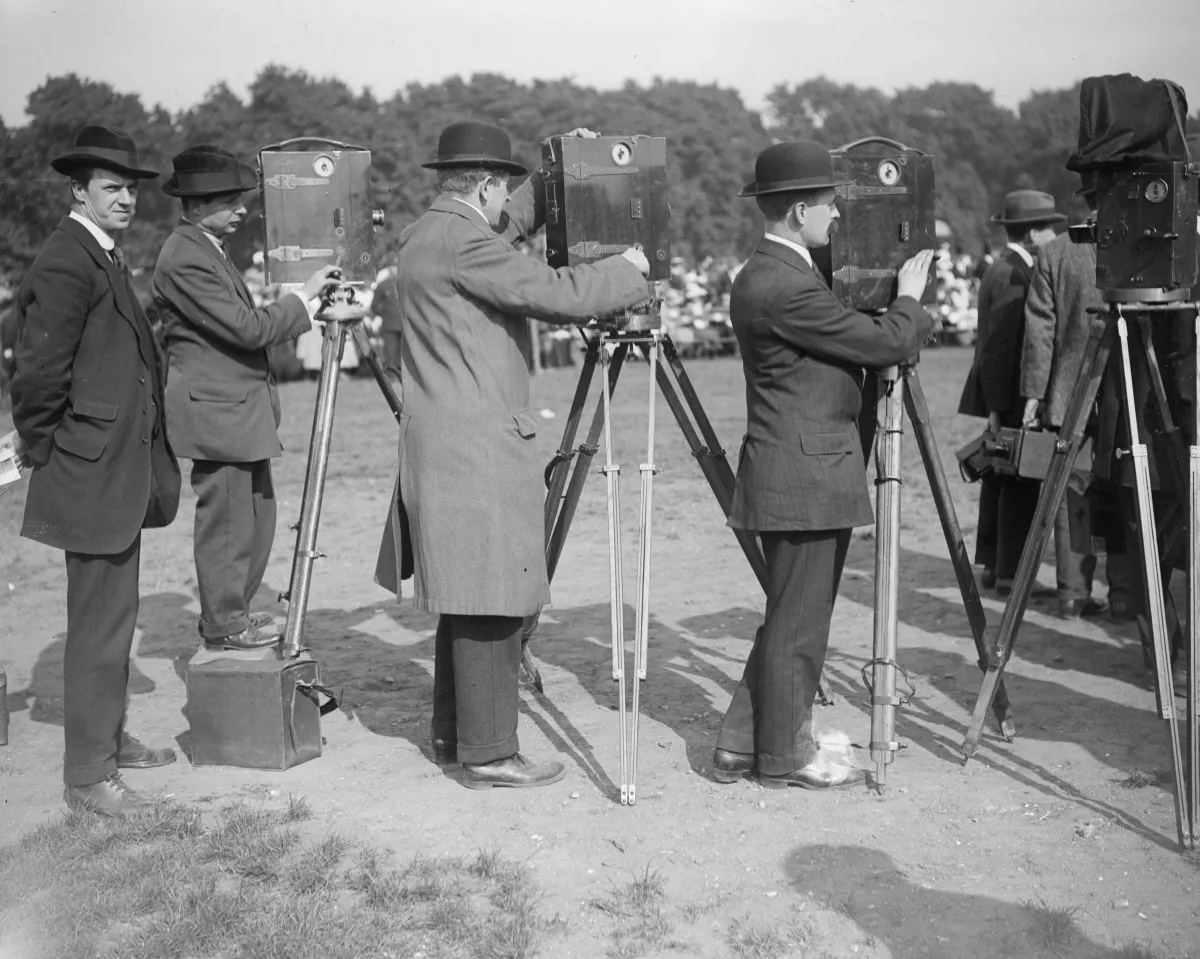Why Did World War I Happen?
In this free resource on World War I, explore the causes and effects of the Great War to understand how the conflict shaped world history.
Perhaps it comes as no surprise, but the 2017 box office hit Wonder Woman took a few creative liberties in its depiction of World War I. For instance, the film portrayed Ares, the god of war, as the evil mastermind behind the conflict. In reality, it was not the gods who pushed humanity toward conflict. World War I was caused by the actions of ordinary people and political leaders. However, World War I was so violent, costly, and traumatic that it is tempting to blame an all-powerful deity bent on humanity’s destruction.
A Short History of World War I
More than twenty countries that controlled territory on six continents would declare war between 1914 and 1918, making World War I (also known as the Great War) the first truly global conflict. On one side, Britain, France, and Russia formed the Triple Entente (also known as the Allied powers or, simply, the Allies). On the other side, Austria-Hungary, Germany, and Italy made up the Triple Alliance (also known as the Central powers). Those alliances, however, were hardly static, and during the war Italy would change sides; the United States, Japan, and many other nations would join the Allied powers; the Ottoman Empire and Bulgaria would join the Central powers; and Russia would withdraw altogether due to revolution back home.
By the war’s end in 1918, the Allied powers emerged victorious. However, both sides were left reeling from the scale of the violence. New technologies like chemical gas and long-range artillery drove conflict to cruel new heights. Nine million soldiers died while the civilian death toll likely exceeded ten million. Infectious diseases also ran rampant, fighting leveled infrastructure, and the financial toll of the war was immense. Following the conflict, most of the European continent was left in economic disarray.
In trying to make sense of this death and destruction, one obvious question stands out: Why did World War I break out in what had been a mostly peaceful and prosperous continent?
How did World War I start?
Experts continue to fiercely debate this question. Yes, the 1914 assassination of Archduke Franz Ferdinand, heir to the throne of Austria-Hungary, triggered a series of declarations of war. However many scholars argue that several other factors had been creating the conditions for conflict in Europe for decades prior. As the military historian Liddell Hart wrote, “Fifty years were spent in the process of making Europe explosive. Five days were enough to detonate it.”
This resource explores the factors that led to the outbreak of World War I and how the conflict reshaped society.
Origins of World War I
To understand the origins of World War I, let’s first go back to the early 1800s.
For centuries, a competing patchwork of European empires and kingdoms had waged near-constant war with each other. These conflicts were generally fought over land, colonies, religion, resources, and dynastic rivalries. As a result, the borders within the continent shifted frequently.
However, after the defeat of French Emperor Napoleon Bonaparte, who had conquered most of Europe, representatives from several European powers were eager to end the cycle of war. In 1814 and 1815, these representatives met in Vienna to establish a framework for peace.. What emerged was a series of agreements and understandings that ushered in an unusual period of relative stability for the continent. The resulting diplomatic system, known as the Concert of Europe, sought to preserve peace by supporting existing dynasties over revolutionary movements.
With peace at home, Europe enjoyed a century of immense progress and global influence. Technological innovations—like the development of machine production, steel, electricity, and modern chemistry—enriched the continent. Meanwhile, improvements in shipping, railroads, and weapons allowed countries to project their power farther abroad. As a result, Europe’s strongest empires—namely, Belgium, Britain, France, the Netherlands, Portugal, and, later, Germany, Italy, and Russia—controlled much of the world throughout the nineteenth century.
However, this period of European peace and prosperity would not last forever. Many historians believe things began to unravel in the mid-1800s. The various regional conflicts and wars to unify the countries of Germany and Italy reintroduced costly warfare to the continent. But, unequivocally, Europe’s century of stability had come to a cataclysmic end with World War I.
Let’s explore three factors that brought about this great unraveling.
Three Causes of World War I
The Rise of Germany
Following the Napoleonic Wars, Europe experienced a rough balance of power on the continent. In other words, the region’s strongest countries typically avoided massive conflicts with each other. The odds of conflict were mitigated because Europe’s largest powers were fairly equal in strength. This meant that the costs of going to war would almost certainly outweigh any expected benefits.
Initially, the strength of Austria, Britain, and Russia preserved peace and order. Later, Britain and Prussia (which would become part of Germany in 1871) maintained this balance as the continent’s strongest countries. The two nations both had large populations, towering economies, and robust militaries.
However, power dynamics shifted in the latter half of the nineteenth century.
Britain—the world’s largest empire and the biggest naval and economic power—saw its relative strength begin to fade in the mid- to late-1800s. For generations, Britain had enjoyed global primacy through its strong trade ties, unparalleled navy, and sprawling empire. Britain's imperial power provided access to natural resources and markets around the world. However, the costs of maintaining such a vast, globe-spanning empire began to mount. Additionally, by the end of the nineteenth century, rapidly industrializing countries like the United States and Germany began to outcompete Britain. As a result, Britain’s technological and manufacturing edge over the rest of the world faded.
Germany only emerged as an independent country in 1871 when Prussian leader Otto von Bismarck unified the nation. Prior to unification, Germany had been thirty-nine independent states—made up of a group of people fairly unified in language and culture, though not religion—into a single political unit. This new, united Germany would soon become exceedingly wealthy through industrialization. The country quickly began to showcase its power on the global stage through the acquisition of colonies in Africa.
Although Bismarck worked to preserve peace on the continent by balancing among the other powers, later leaders began to assert German dominance. Notably, historians describe Kaiser Wilhelm II as insecure and arrogant. Wilhelm possessed unbridled ambition to claim Germany’s “place in the sun.” However, his desire to improve Germany’s international standing ultimately translated into recklessness. For example, he abandoned the Reinsurance Treaty with Russia in 1890, which led to Russia becoming friendly with France—an old enemy to Germany—and then with Britain.
Wilhelm spoke openly—and belligerently—about his desire for German economic and military supremacy and endeavored to make this vision a reality. In particular, he invested heavily in military spending. Wilhelm hoped to build a navy that could challenge Britain’s globally renowned fleet. This rapid militarization ignited an arms race on the continent, which unsettled Europe’s balance of power.
Nationalism
Nationalism is a powerful force that unites people based on ethnic, linguistic, geographic, or other shared characteristics. In certain contexts, it can serve as a basis of unity, inclusion, and social cohesion for a country. But when taken to extremes, nationalism can fuel violence, division, and global disorder.
In the lead-up to World War I, nationalism fueled intense competition in Europe. The continent’s most powerful countries frequently tried to best each other through their empires, militaries, and technological innovations. Meanwhile, governments, the new mass print media, and schools and universities reinforced messages of each country’s superiority.
With memories of the Napoleonic wars long since faded, countries viewed war as a quick and easy way through which to achieve glory. In fact, some Europeans celebrated the arrival of World War I. Parades and cheering spectators sent off their soldiers to the front lines. Young men rushed to recruiting offices eager not to miss the opportunity to serve. Most people believed that “the boys will be home by Christmas.” Few imagined that the war would drag on for four years in such horrific fashion.
Nationalism unified countries like Britain, France, and Germany—albeit to dangerous extremes. However, the same force also pulled other European empires apart. In particular, Austria-Hungary, the Ottoman Empire, and Russia struggled to promote a cohesive national identity. Given their populations’ vast internal differences along ethnic, cultural, linguistic, and religious lines, these once-great European empires began to fracture.
In fact, the first shot of World War I—the assassination of Archduke Franz Ferdinand of Austria—came at the fault lines of one of those multiethnic empires. Ferdinand’s assassins executed their attack in the name of Slavic nationalism.
Alliance Networks
Thus, Europe marched toward war—or, rather, as one historian describes the consequences of careless decision making, the continent found itself “sleepwalking” its way to World War I.
How did World War I change the world?
World War I was incredibly destructive. But perhaps most tragic of all, the “war to end all wars'' ultimately did nothing of the sort. Historians assert that both the conflict and its aftermath sowed the seeds for a second—and even deadlier—world war just two decades later.
Although World War I did not curtail future conflict, it nevertheless transformed society across the United States, Europe, the Middle East, and sub-Saharan Africa. Let’s explore a few examples:
New Age of Warfare: World War I ushered in a new age of lethal military technology. These military innovations include landmines, flamethrowers, submarines, tanks, and fighter planes. Aerial photography allowed both sides to create sophisticated maps of their opponents’ positions. Long-range artillery gave soldiers the ability to shoot at enemies they could not see. And the introduction of weapons of mass destruction, including chemical gas, were used to break through the dug-in stalemates of trench warfare. The scale and severity of such combat led tens of thousands of veterans to experience debilitating psychological trauma. This condition, then known as shell shock, is now commonly referred to as post-traumatic stress disorder.
In addition, although previous wars were largely confined to the battlefield, World War I was a “total war.” The conflict saw the complete erosion of the distinction between civilian and military targets. Germany, for example, used submarines to attack civilian ships and used airships known as zeppelins to bomb cities in Britain. The war also featured mass killings and expulsions of particular ethnic groups. For example, Armenians were violently excluded from the Ottoman Empire, a practice that many scholars would later term genocide.
Innovations Beyond the Battlefield: In addition to new forms of weaponry, many medical practices and common household items have their origins in war. During World War I, doctors began using sodium citrate to stop blood from clotting. Doctors also performed some of the first successful skin grafts, which paved the way for modern plastic surgery. Additionally, the invention of splints greatly reduced the lethality of certain injuries: before the war, four out of every five soldiers with a broken femur died; after the introduction of the splint, four out of every five survived.
The Great War also led to the development of Kotex, one of the first branded sanitary products (used as a cheaper and more absorbent wartime alternative to cotton bandages), the popularization of exercises like pilates (invented by a captured German bodybuilder to stay fit), and the rise in print cartoons (used both as military propaganda and to help civilians and veterans process the horrors of war).
Daylight Saving Time: Daylight saving time (DST) was developed during World War I to conserve energy and free up more daylight hours for battle. Although DST was meant to be a temporary fix, essays dating back decades argued for its implementation; in 1794, Benjamin Franklin made the case in financial (candle cost-savings), productivity (longer workdays), and moral (a remedy for laziness) terms. Although most of the world repealed DST when the first World War ended, World War II led to its quick re-adoption. DST was popularized as a long-term solution following the end of that conflict decades later. The year-round DST we observe in the United States was introduced in the winter of 1973 amidst a global energy crisis.
Vegetarian Sausage: : Before World War I, these modern grocery store staples didn’t exist. Vegetarian sausage was created in sausage-loving Germany during the war as a cheap way to add protein to meals amidst frequent food shortages. Cologne’s then-mayor Konrad Adenauer made his Kölner Wurst or “Cologne sausage” using soya, flour, corn, barley, and ground rice. Despite its use in wartime, the sausages were infamously bland. Meat substitutes available today have made big gains in texture and taste but rely on many of the same ingredients from Adenauer’s original recipe.
Plastic Surgery: Before World War I, people who experienced disfiguring wounds had limited options to choose from. However, as the number and magnitude of facial disfigurations skyrocketed among soldiers fighting in the First World War, the medical community worked quickly to invent reconstruction procedures. Dr. Harold Gillies is credited with the idea to use patients’ own facial tissue to decrease the chance of transplant rejection, leading to rapid innovation in the field of plastic surgery. Following this innovation, treatment capabilities ranged from successful skin grafts to the first sex reassignment surgeries.
Everyday Words and Phrases: Next time you “ace” a test, unexpected news leaves you “shell shocked,” or that highly anticipated movie turns out to be a “dud,” you’re using language directly handed down from wartime. From World War I, English gained words like “lousy,” which transformed from an adjective to describe lice infestations to mean weary. The British also refashioned the term“trench coat,” which transitioned from battlefield necessity to universal fashion statement. World War II added household brands Spam (a mashup of “spiced” and “ham”) and Jeep (from the initials GP, which described its wartime roots as a general purpose vehicle). The global entanglement also created a melting pot of cultural ideas and terms. For example, describing something comfortable or privileged as “cushy,” is a direct contribution to the English language from Indian troops who fought alongside the British in World War I.
Wristwatches: Before we could check the time with the phones in our pockets, most people had to dig out their pocket watch to accomplish this essential task. That proved to be quite inconvenient for soldiers in the trenches, who were also operating without church bells and factory whistles to orient themselves in time. Wristwatches, the obvious solution to this problem, were seen as feminine accessories before World War I, a perception that changed rapidly as they became a crucial part of soldiers’ gear. The phrase “synchronize your watches” came to symbolize their importance on the battlefield where fighting had to be precisely scheduled and timing was a vital tool for communication and survival.
Newsreels: The advent of the twenty-four-hour news cycle stems from one of the earliest forms of broadcast: newsreels. Without televisions, cell phones, or social media, people would line up at movie theaters to watch hour-long loops of news and entertainment features. Early video cameras were bulky, so newsreels rarely included war reporting at the start of World War I. Instead, early war news covered parades, sports events, and cultural moments like royal weddings. Yet as the war progressed and the public hungered for updates, newsreels began to include footage from the conflict. Video cameras produced unprecedented imagery for the time, including the launch of military ships, civilians fleeing their villages, prisoners of war, and cratered battlefields. Video documentation led to a new awareness about wartime destruction.
Changing Roles for Women: As Europe’s militaries sent millions of men to the front lines, women played an increasingly important role in professional life back home.
Thousands of women gained a taste of personal and financial independence as they staffed factories, offices, and farms to support the war effort. Pointing to these valuable contributions, women’s rights groups successfully lobbied for suffrage (voting rights) in numerous countries between 1917 and 1920. (Workers’ rights groups also highlighted these efforts—from both men and women—to push for stronger unions and greater collective bargaining power).
Women’s fashion even changed during the war too. Metal shortages led governments to ask women to stop buying corsets, leading to the creation of brassieres. And as more women began to work outside the home, they increasingly adopted factory-safe attire such as pants.
Certainly not all women experienced economic advancement during this time. World War I widowed at least three million women. As a result, these women were left to face extreme financial hardship after the conflict.
Rise and Fall of Powers: The end of World War I marked a shift in global powers. The war culminated with the fall of major empires, such as the Ottoman Empire, and the rise of a new global power, the United States.
The End of World War I
World War I brought about the collapse of four empires: the Austro-Hungarian, German, Ottoman, and Russian.
In many cases, the victors of World War I absorbed territory from those former empires. Britain and France carved up land belonging to the Ottoman Empire. Meanwhile, Germany was forced to cede its colonies in Africa and the Pacific as part of the terms of the Treaty of Versailles. This peace treaty set the terms for the end of World War I in 1919. The breakup of these empires also resulted in the creation of new countries in Europe such as Czechoslovakia and Yugoslavia in addition to the reemergence of old ones like Poland.
With World War I leaving even Europe’s victors badly weakened, the global center of power began shifting across the Atlantic to the United States. Even before the war, the United States had surpassed Britain to become the world’s strongest economy. After the war, the United States emerged in an even more powerful position. In 1919, Washington was uniquely situated to shape the new international order. However, the nation balked at the opportunity, as the American public was largely uninterested in international leadership at the time. Instead,the country retreated into a period of isolationism.
It would take a second world war two decades later for the United States to fully become the global power it is today.






